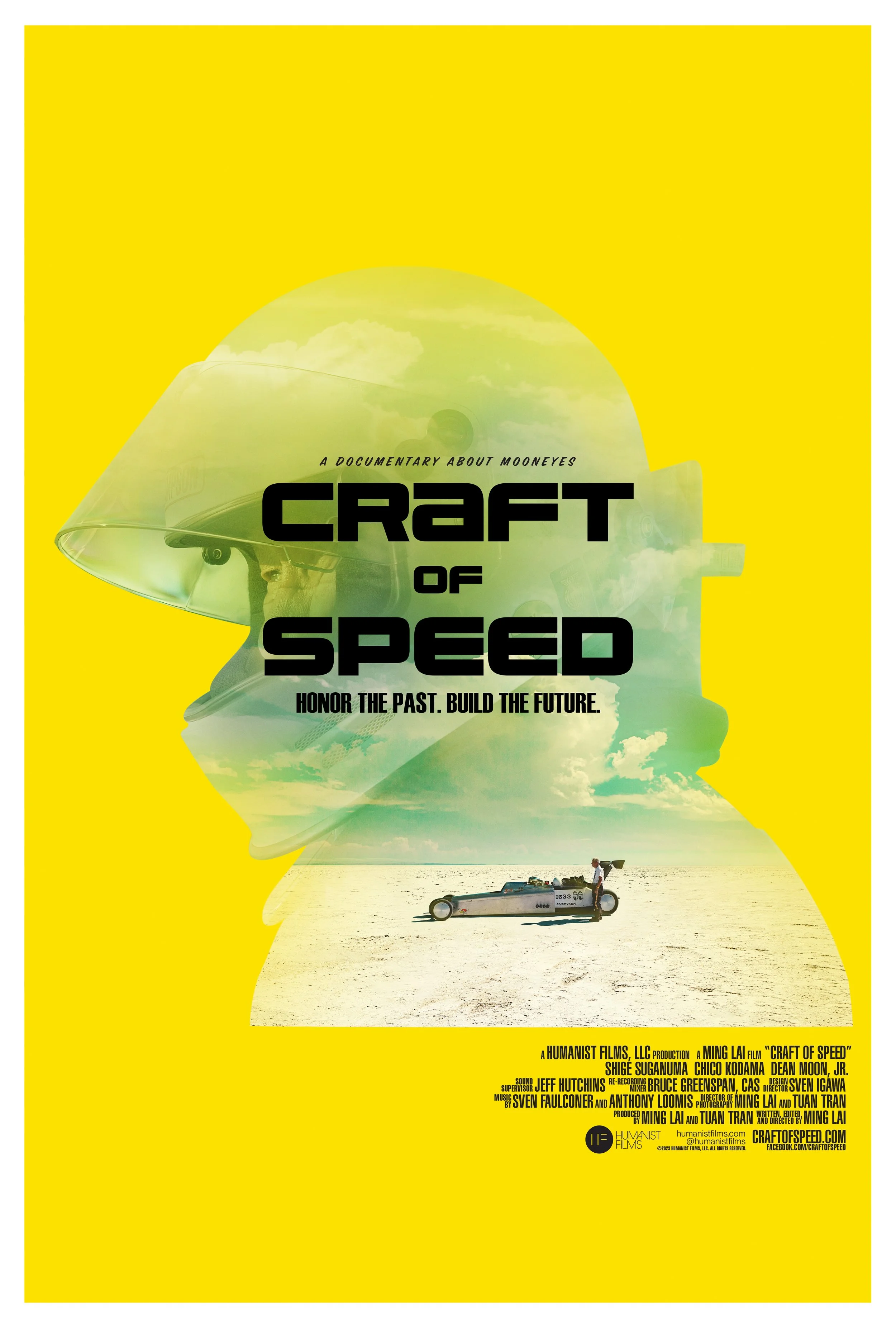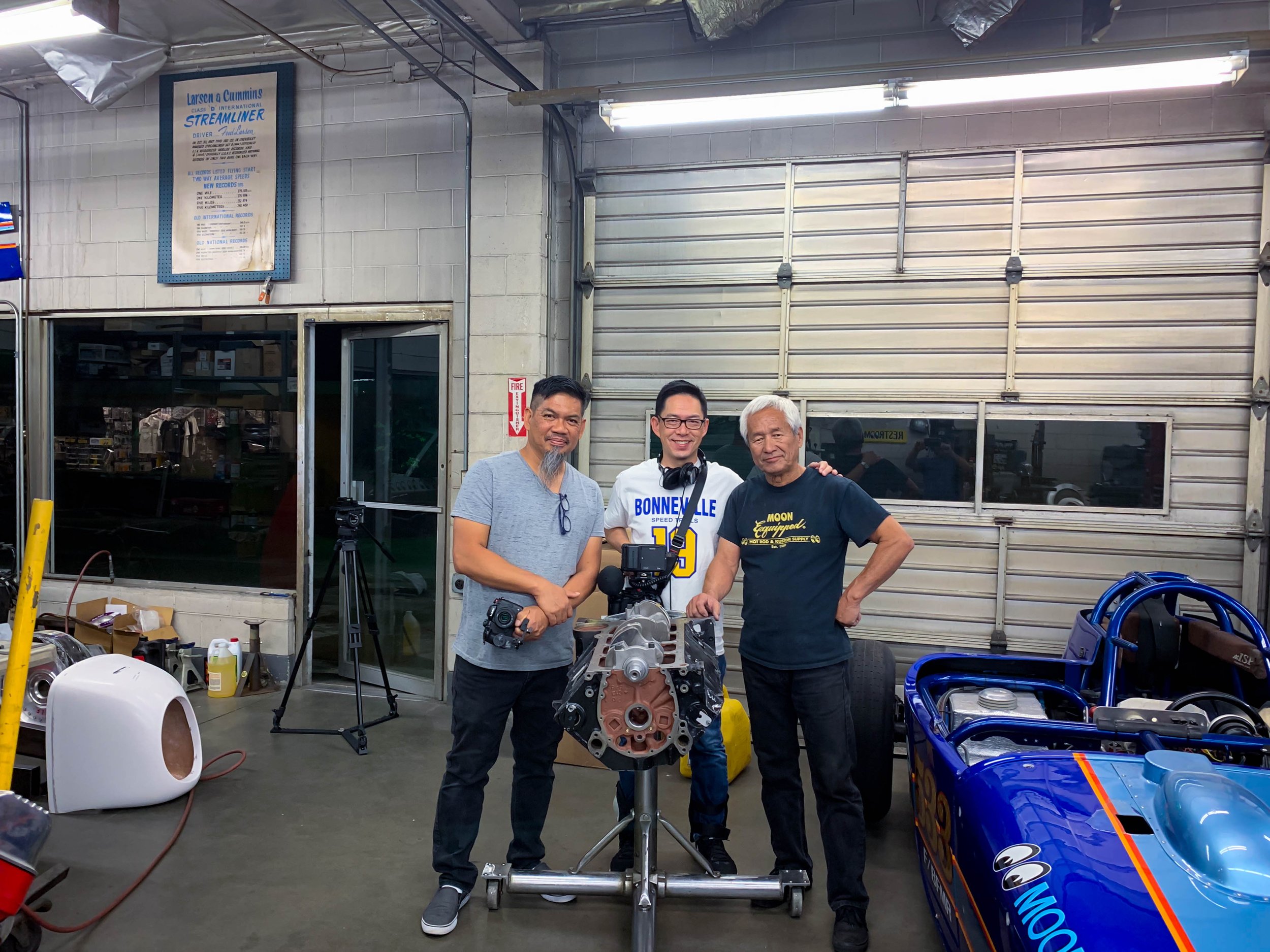In our feature documentary, “Craft of Speed,” we tell the incredible story of MOONEYES, one of the most famous brands in motorsports. While many people know and love their attention-grabbing logo of two eyes glancing to the side, few people know the long history of the company, which started in the hey day of hot rodding in the 1950s. Our film takes you behind this renowned logo to its rich human story.
For 30 years, Shige Suganuma and Chico Kodama, two Japanese/Japanese American hot rodders, helped save Moon Equipment Company, an iconic American speed parts company, rebrand it as MOONEYES, preserve legendary founder Dean Moon’s legacy, and popularize hot rod culture in Asia. As Asian/Asian American pioneers in their industry, they battled against racism and xenophobia and ultimately created a global following. Now, Shige is attempting to grow hot rod culture despite declining interest in hot rods, and Chico is handcrafting a new race car to try to break a second land speed record at Bonneville Salt Flats.
My team and I started the project in October 2019. After four years of passionate work, the film is now completed. We survived the devastating pandemic, tough economy, widespread social unrest, and many technical challenges. Our film wouldn’t be possible without the support of Shige Suganuma, Chico Kodama, Dean Moon, Jr., the Mooneyes family, our sponsors, donors, and supporters.
I served as the Producer/Writer/Director as well as the Director of Photography/Editor/Colorist. For more complex interviews or larger scale events, I worked with Tuan Tran as a Producer/Co-Director of Photography. He did all of the gimbal and drone photography. We also recorded our own sound. In addition, we did our own behind-the-scenes photography.
Because of the pandemic, it was difficult and cost-prohibitive to travel to Japan with long quarantine times. So I worked with a local crew to film the scenes there: Kan Taniguchi, Producer; Peter Grasse, Producer/Mr. Positive; Meng Du, Assistant Producer/Mr. Positive; and James Honeycutt, Director of Photography.
The film’s 4096 X 1716/2.39:1 aspect ratio was inspired by the epic landscape of the Bonneville Salt Flats in Utah and Chico’s long rear engine modified roadster. Framing, composition, and camera movement were very precise to convey the craftsmanship of Mooneyes in creating their famed speed parts. Wide framing with ample negative space were used to express the loneliness of the craftsmen in their demanding work. The camera was often voyeuristic, peeking through windows or doorways to get a glimpse of the inner world of the craftsmen.
In the scenes of the breathtaking Bonneville Salt Flats, I was influenced by some of my favorite nature photographers, Ansel Adams and Sebastiao Salgado. In the scenes of the MOONEYES craftsmen and the vintage machines in the historic MOONEYES Machine Shop, I paid homage to the industrial photography of Irving Penn and Lewis Hine.
Because of my subject of passing history, I explored the Japanese concept of “mono no aware” (“the pathos of things” or “sadness about the impermanence of things”) through the film’s aesthetics, specifically nuanced framing, composition, camera movement, and editorial pacing.
I’m a huge admirer of Edward Hopper’s transcendent artwork. While he’s described as a realist painter, his paintings often depict scenes that are very evocative and even melancholic. Even though it wasn’t intentional, I think that in conveying the complex idea of “mono no aware,” the film resonates with Hopper’s powerful artwork.
Inspired by Japanese folding “byobu” screens that depict expansive narrative, historical, and natural scenes, I tried to replicate them cinematically with long pans that slowly reveal its subject matter and invite the viewer to contemplate the images and their meaning.
The film is observational in its approach. So I needed to be nimble, responsive, and unobtrusive. I modeled my approach after photojournalists and video journalists who work and travel with minimal gear. This required a camera kit that was small, light, fast, and powerful.
After a lot of research, I chose the Panasonic Lumix DC-GH5 as my main camera. Because it’s a micro four thirds camera, it’s very compact. I paired it with an equally small Panasonic Lumix G X Vario 12-35mm f/2.8 II ASPH. POWER O.I.S. lens, which covered most of my shooting.
The GH5 is also very powerful, being able to shoot Cinema 4K (4096 X 2160) at 400 Mbps, 4:2:2/10 bit, ALL-Intra. When it came out in 2017, it was one of the highest spec’d cameras in a small form factor, with a relatively low pricepoint. I shot everything in V-LOG L in order to, as Panasonic claims, “gain wide dynamic range with 12 stops.” The GH5’s image quality is beautiful—sharp with natural colors. Its Dual I.S. feature allowed me to shoot handheld and not need a gimbal.
My Co-D.P., Tuan, owns a Panasonic Lumix DC-GH5S, which is a nice complement to my GH5 for lowlight shooting. He also has a Panasonic Lumix DC-GH4, which we used for a C camera or backup camera. In addition to a collection of Panasonic and Canon lenses, he has a set of fast Rokinon prime lenses, which we used for shallow depth-of-field interviews.
Tuan was also equipped with a Canon C70, and our Second Unit/D.P. in Japan, James Honeycutt, was outfitted with a Canon C300 Mark II. Both cameras matched well with the GH5 and GH5S.
To film Chico Kodama doing land speed racing at the Bonneville Salt Flats and create an immersive feel, I used the GoPro Hero8 Black and GoPro Hero9 Black, mounted on the side of Chico’s race car. Both cameras have HyperSmooth 2.0 and 3.0 electronic image stabilization, respectively, which effectively eliminates any camera shake.
Because the GH5’s LCD is a bit small for my eyes, I chose an Atomos Ninja V for monitoring. At 5 inches, it’s the ideal size for easy viewing. Plus, it’s the perfect size to match the GH5’s compact body. With 1,000 cd/m2 (nits) brightness, it’s bright enough for most outdoor situations. However, at the Bonneville Salt Flats, I had to add a SmallRig cage and sunhood to the Ninja V to block out the blinding sun and reflective salt.
I appreciated all of the Ninja V’s monitoring tools, including the waveform monitor, focus peaking, aspect ratio guides, and 2X magnification. I loved how it could shoot to ProRes 422 HQ, allowing me to easily view the footage on a QuickTime player and immediately edit it on Adobe Premiere Pro without having to transcode it first, which is time consuming.
For the Ninja V’s storage, I opted for a Sony AtomX SSDmini, which fits flush with the back of the monitor. With its whopping 2TB size, I could shoot an entire day without changing the SSD and spending precious time downloading it. The SSD was ideal for long interviews because I didn’t have to keep switching out SD cards and disrupt the interviews.
To mount the Ninja V onto the GH5, I used a combination of a beautiful, strong 8Sinn cage and inexpensive, but well-made SmallRig parts. I love shooting handheld so I appreciated the sculpted right grip of the 8Sinn cage, which molds perfectly with the GH5’s grip without adding too much bulk. I balanced the left side of the camera with a SmallRig universal side handle. Everything was mounted rock solid with SmallRig NATO rails and clamps. Plus, I could easily adjust, reconfigure, or disassemble the camera rig.
Because my camera rig was relatively light, I could hold it all day. If I needed to rest or move, I could let it hang down or sling it to my side with a comfortable Peak Design Slide Lite strap. Because I’m also a photographer, I like being able to operate my video camera like a still camera.
For an onboard mic, I opted for a Deity V-Mic D3 Pro and later a Deity V-Mic D4, which are relatively small and have a super cardioid pick-up pattern. I loved how the mics have stepless gain knobs so I could adjust the gain on the fly and avoid using a preamp/XLR microphone adapter, which would’ve made my camera rig bigger and taller.
For interviews, I chose a trusty Sennheiser ME 64 cardioid mic and Sennheiser EW 100-ENG G3 wireless lavalier mics into a Zoom F4 field recorder and later a Zoom F6 field recorder. The 32-bit float recording capability of the Zoom F6 allowed me to record the extremely loud sounds of land speed racing or drag racing without distortion.
For camera support, I used a workhorse Sachtler DV-8 tripod as well as a Manfrotto 290 MM294C4 monopod for more mobility or tighter areas. For gimbal shots, I employed a Zhiyun-Tech Weebil Lab.
It took a long time to build this camera and audio kit, tailoring it to my needs. And it continues to evolve. However, it satisfies most of my requirements for it to be small, light, fast, and powerful. Despite the hard work to perfect it, you ultimately want it to disappear so that you can concentrate on the moment, operating it without thinking.
I edited and color graded the film with Adobe Premiere Pro initially on a Mac Pro (Late 2013) and later a MacBook Pro (2023) with a M2 Max chip. For storage, I used a massive amount of G-Technology drives and ultimately a giant OWC ThunderBay drive.
Composers, Sven Faulconer and Anthony Loomis, created the powerful music, inspired by the cyclical machine sounds of the historic MOONEYES Machine Shop. Sven composed the beautiful music for the Academy Award-winning short documentary, “The Elephant Whisperers.”
Sound Supervisor/Sound Designer & Editor/Foley Artist, Jeff Hutchins, designed the immersive soundscape. He’s known for his exceptional work on “SpongeBob SquarePants” and has won five Emmys and seven Golden Reel Awards for excellence in the sound industry.
And Dialogue Editor/Re-Recording Mixer, Bruce Greenspan, edited the dialogue and mixed the sound. He mixed the terrifying sound for the Netflix docuseries, “Night Stalker: The Hunt for a Serial Killer.” We did the final review of our 5.1 mix at Monkeyland Audio, owned by sound industry veteran Trip Brock.
Design Director/Graphic Designer, Sven Igawa, designed our beautiful key art and advised on the titles of the film. He’s created successful brand identities and advertising campaigns for many international companies, including HBO, Mountain Hardware, PlayStation, and Quiksilver, and has won numerous awards in identity, packaging, and collateral.
“Craft of Speed” recently received a prestigious Silver Remi Award in the “Features - Documentary” category from the 57th WorldFest-Houston International Film Festival.
Elana Scherr, Senior Editor/Features of “Car and Driver,” says about the film, “It’s too good a history to go unshared.”
“Craft of Speed” will be celebrating its U.S. Premiere, presented by MOONEYES and Humanist Films. A live screening will take place at the beautiful Lions Automobilia Museum in Rancho Dominguez, California on Saturday, 7/20/2024 and then a virtual screening for the U.S. will be held from Saturday, 7/27/2024 to Saturday, 8/3/2024.
To buy tickets to the “Craft of Speed” U.S. Premiere:
craftofspeed.eventive.org
To learn more about “Craft of Speed”:
craftofspeed.com
































